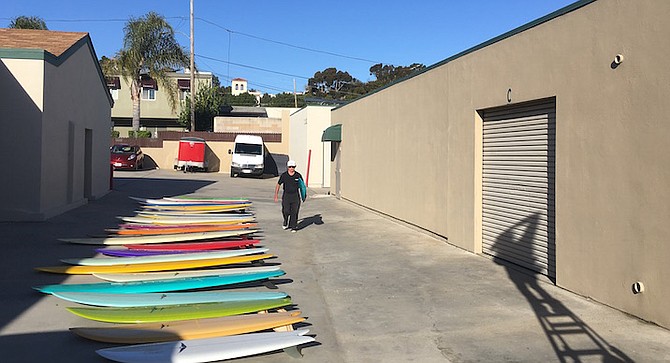 Facebook
Facebook
 X
X
 Instagram
Instagram
 TikTok
TikTok
 Youtube
Youtube

“When you add it all up, a surfboard costs a few cents a wave.” — Legendary surfboard shaper, Bill Caster
Generally ranging between 800 and 1,200 dollars each, custom surfboards seem expensive until considering the seven steps involved in making them: 1) shaping a foam blank. 2) Laminating the shaped blank. 3) Coating the laminated blank with resin. 4) Glassing in fins, or routing in fin boxes. 5) Sanding the board. 6) Glossing the board. 7) Fine sanding and polishing the board. Each of these steps requires a skilled craftsman to accomplish. When considering this and that one primary ingredient of surfboard building, resin, has quadrupled in price in less than a decade, surfboards seem like a bargain.
Aside from a few sticks of antique furniture handed down from grandparents, few of us own any handmade items. New handmade furniture is still more rare since it can equal the price of a new car. A new custom surfboard, one made specifically for your height, weight, surfing ability, and in whatever colors you chose costs a fraction of that amount.
Still, when compared to a $150 Wavestorm, $800-plus seems like a lot. Wavestorm, the top selling surfboard in the world, mass-produces hundreds of thousands of boards that can resemble an eight- to ten-foot surfboard-shaped sponge. Their construction is much more detailed than a sponge, and the boards are more durable and safer than their foam and fiberglass cousins.
As the name unintentionally implies, Wavestrom has hit traditional surfboard builders like a tsunami. A second wave to slam the domestic surfboard market comes from traditional looking surfboards being built overseas by factory workers. While skilled in their labors, these workers generally have little contact with the ocean, and rarely understand the performance differences between a 5’8” Thruster and a 9’6” Noserider. Does it matter, Jay Grygera, who owns and operates the surfboard glassing shop, Grygera & Sons with his father Jeff and brother Gino thinks so. Jay had this to say about the invasive species. “Those overseas boards can look good, but they often need repair because the manufacturers have cut corners in making them. One of the unseen ways they do this is in the installation of the fin box. More than once a customer has come to us with a fin box broken out. When I cut away the exterior fiberglass, I can see that the box has been installed without any fiberglass to reinforce it. Another reason locally made surfboards make sense, is because it takes someone who regularly surfs your local breaks to recommend the best boards for local surf spots.”
Grygera & Sons along with the other dozen or so glass shops in the San Diego area have somehow managed to hang on to a decreasing percentage of the surfboard market. According to Grygera, “Most of our custom orders are from surfers who began surfing decades ago, when most surfboards were handmade."


“When you add it all up, a surfboard costs a few cents a wave.” — Legendary surfboard shaper, Bill Caster
Generally ranging between 800 and 1,200 dollars each, custom surfboards seem expensive until considering the seven steps involved in making them: 1) shaping a foam blank. 2) Laminating the shaped blank. 3) Coating the laminated blank with resin. 4) Glassing in fins, or routing in fin boxes. 5) Sanding the board. 6) Glossing the board. 7) Fine sanding and polishing the board. Each of these steps requires a skilled craftsman to accomplish. When considering this and that one primary ingredient of surfboard building, resin, has quadrupled in price in less than a decade, surfboards seem like a bargain.
Aside from a few sticks of antique furniture handed down from grandparents, few of us own any handmade items. New handmade furniture is still more rare since it can equal the price of a new car. A new custom surfboard, one made specifically for your height, weight, surfing ability, and in whatever colors you chose costs a fraction of that amount.
Still, when compared to a $150 Wavestorm, $800-plus seems like a lot. Wavestorm, the top selling surfboard in the world, mass-produces hundreds of thousands of boards that can resemble an eight- to ten-foot surfboard-shaped sponge. Their construction is much more detailed than a sponge, and the boards are more durable and safer than their foam and fiberglass cousins.
As the name unintentionally implies, Wavestrom has hit traditional surfboard builders like a tsunami. A second wave to slam the domestic surfboard market comes from traditional looking surfboards being built overseas by factory workers. While skilled in their labors, these workers generally have little contact with the ocean, and rarely understand the performance differences between a 5’8” Thruster and a 9’6” Noserider. Does it matter, Jay Grygera, who owns and operates the surfboard glassing shop, Grygera & Sons with his father Jeff and brother Gino thinks so. Jay had this to say about the invasive species. “Those overseas boards can look good, but they often need repair because the manufacturers have cut corners in making them. One of the unseen ways they do this is in the installation of the fin box. More than once a customer has come to us with a fin box broken out. When I cut away the exterior fiberglass, I can see that the box has been installed without any fiberglass to reinforce it. Another reason locally made surfboards make sense, is because it takes someone who regularly surfs your local breaks to recommend the best boards for local surf spots.”
Grygera & Sons along with the other dozen or so glass shops in the San Diego area have somehow managed to hang on to a decreasing percentage of the surfboard market. According to Grygera, “Most of our custom orders are from surfers who began surfing decades ago, when most surfboards were handmade."
Comments